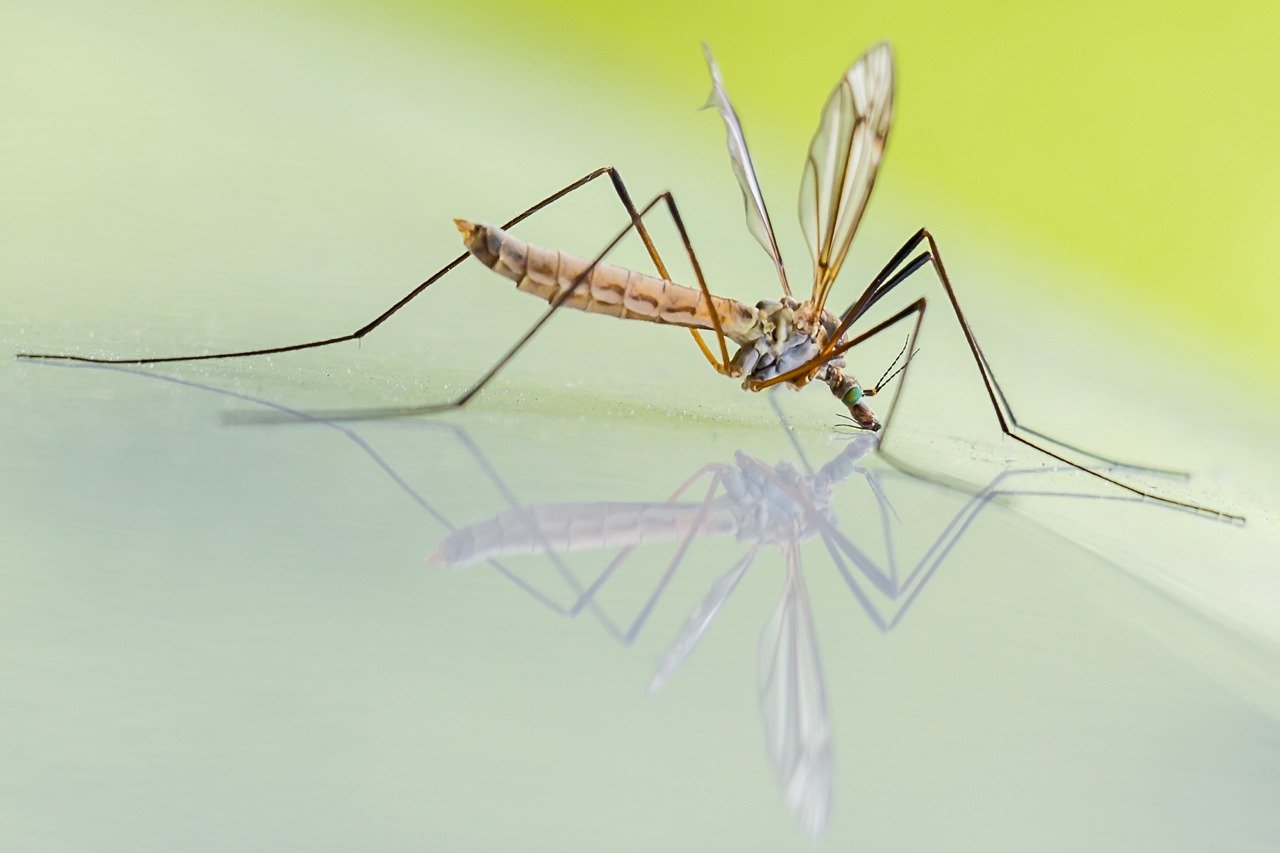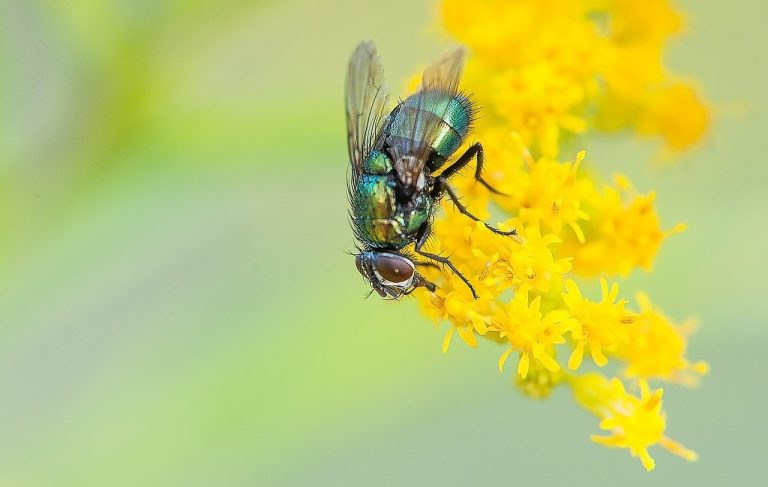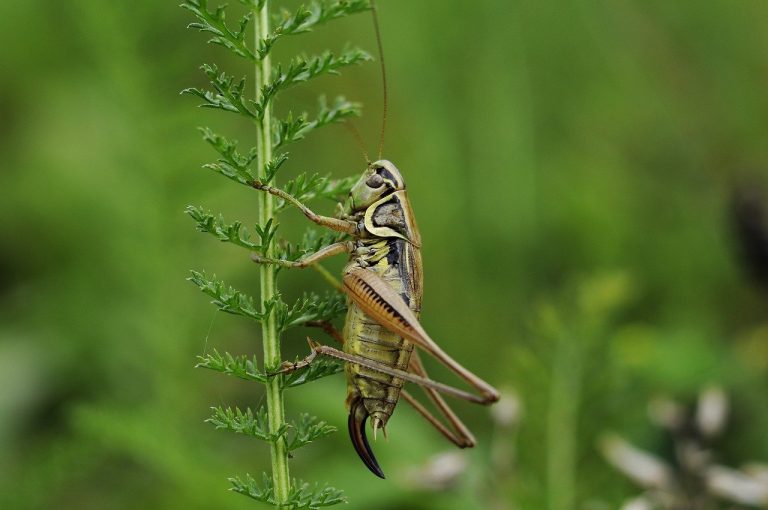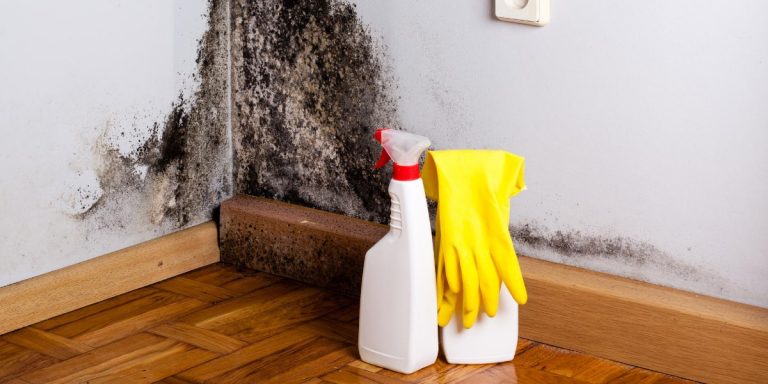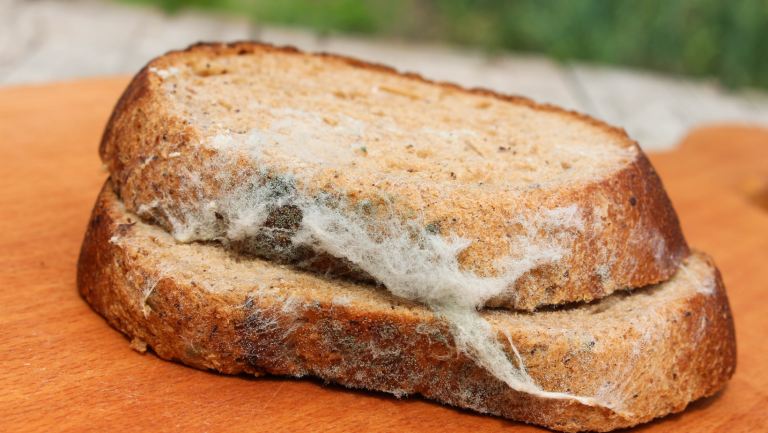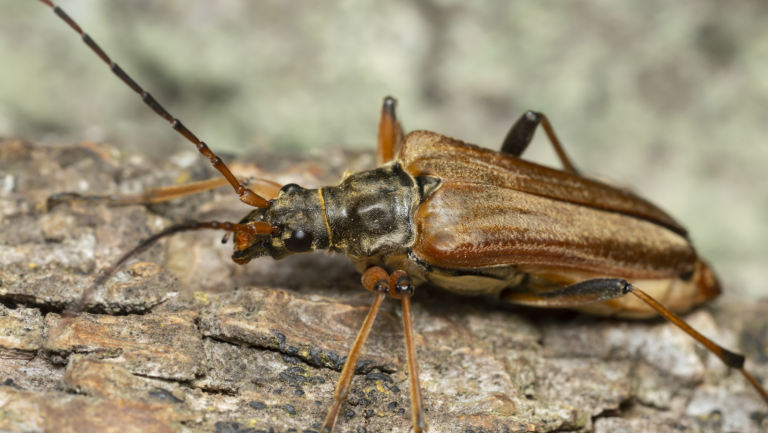How to Get Rid of Mosquitoes? Natural, Herbal, and Chemical Treatment
A mosquito is any member of a group of about 3500 species of small insects belonging to the order ‘Diptera’. Within Diptera, the mosquitoes constitute the family Culicidae. Mosquitoes have a slender segmented body, one pair of wings, one pair of halteres, three pairs of long hair-like legs, and elongated mouthparts.
The mosquito has a life cycle of egg, larva, pupa, and adult stages. Eggs are laid on the water surface; they hatch into motile larvae that feed on algae and organic material. Females need iron and protein to produce eggs which they get from human blood. The adult females have tube-like mouthpart proboscis that pierces the skin of the host and draw blood. Thousands of species feed on the blood of mammals, birds, reptiles, amphibians, fish, and some invertebrates.
Due to mosquito saliva that transfers during the bite, it can cause an itchy rash and ingest pathogens. They are carriers of diseases like malaria, dengue, yellow fever, filariasis, zika, West Nile, chikungunya, and others. The number of deaths in the world due to the mosquito-transferred diseases is as high as 700,000 per year. Mosquitoes exist across the world except for Antarctica. More than 3000 species are identified in the Arctic and Subtropics. Different types of mosquitoes have different breeding and feeding habits. There are four most commonly observed mosquitoes which we are discussing now –
House Mosquito (Culex) – Species of mosquitoes that belong to this group include Culex Pipiens and Culex restuans Theobald.
Culex Pipiens is most common –
- With pale brown color with white stripes.
- It is always found in polluted stagnant water.
- Strom drains, birdbaths, pet dishes, and old tires are favorite breeding sites for these mosquitoes.
- Female lays 50-400 eggs at one time that take 10-14 days to hatch.
Culex restuans is a very similar species in looks and habits.
Southern Mosquito (Culex Quinquefasciatus)
Also referred to as Culex fatigans, this type of species of mosquitoes, is most common in tropic and sub-tropic regions. It has the same physical and behavioral aspects as house mosquitoes but is found in the southern area.
It is a night-time feeder and also a carrier of St. Louis encephalitis virus and also can transmit the West Nile virus.
Asian Tiger Mosquito (Aedes Albopictus)
This species carry bright white or silver stripes on the abdomen, thorax, and legs. The female Asian Tiger mosquito is a day-time feeder and can be an aggressive biter whereas males do not bite.
Females lay eggs in clean, standing water. Eggs can hatch in a short time under the correct temperature, hence, the spread is faster. They are weak fliers and can’t fly more than one-half mile from their breeding site.
They are vectors of more than 30 viruses but very few affect humans. These diseases include equine encephalitis, cache valley virus, dengue, etc.
Yellow Fever Mosquito (Aedes Aegypti)
The presence of yellow fever mosquitoes in the USA is for years now. It is stated that the casualties due to yellow fever were more than war casualties during the Spanish-American war. The breeding and behavioral habits are the same as Asian Tiger which is also Aedes species.
However, the population of yellow fever mosquitoes has decreased considerably after the arrival of Asian Tiger mosquitoes.
Natural Home Remedies to Get Rid of Indoor Mosquitoes
One can apply the following easy home remedies to reduce or get rid of mosquitoes.
- Apple cider vinegar – You can use apple cider vinegar in 3 ways, ingest, pour in to stagnant water, or rub on the skin. Additionally, it gives very good health benefits.
If you ingest it, the sweat glands will exude traces of apple cider vinegar which is hated by the mosquitoes and they are surely going to keep away. - Coffee grounds – Did you know that coffee grounds can be used to repel mosquitoes?
You will just need to pour some coffee grounds in standing or stagnant water around your home and this will result in mosquito eggs floating above due to lack of oxygen. Then, you can remove the stagnant water along with eggs. - Citronella – It is typical grass growing in Asia. Its bluish-green color and leaves have the smell of lemon. It is used in candles – when you burn them, the smell enhances and the mosquitoes keep away.
You can also make oil from it in combination with olive oil. This is not for ingestion. - Cinnamon oil – Cinnamon oil is obtained from the outer bark of a cinnamon tree or leaves. With cinnamon oil, you can take care of skin rashes, hair problems, and repel mosquitoes.
To prepare cinnamon oil, you need to take one-liter olive oil and 250 gm. cinnamon and heat them till the cinnamon smell is sensed. Apply on your skin to repel mosquitoes. - Soybean oil – Soybean oil is an amazing mosquito repellent and also, it is an active ingredient in most mosquito repellent chemicals. Only 2% of this oil is needed as an active ingredient.
At home, you can inject some oil on a candlestick and then light it, mosquitoes will run away quickly. - Pinion wood – The dense wood of Pinion which grows in the South-West United States, repels the mosquito to good effect. If burnt, it will kill mosquitoes but will give a good smell to humans. You can use it indoors at the fireplace or outdoor during camping.
- Peppermint oil – Peppermint acts as a quick repellent to the mosquitoes and gives a good smell to humans. You have to mix crushed leaves with olive oil and keep it in sun to settle and give a good dose of peppermint oil.
You need to keep 2 days of which you need to shake the container every 12 hours. - Garlic – Garlic is a great natural insect repeller. It has multiple properties and is much preferred in food preparation. Though it gives bad breath, it keeps mosquitoes at bay.
If you prepare a mixture with water and spray it around the mosquito activity, it works great to repel mosquitoes. - Lemongrass – If you keep the lemongrass plant in the room, it gives you a nice smell but keeps mosquitoes away. Also, you don’t need any supporting material. Just place some lemongrass in the target area and see the results coming fast. If you grow it inside, it will give you better results.
- Alcohol – Most alcoholic beverages work very well on mosquitoes. You can pour beer or other alcoholic beverages in a pan or glass and place it around the room. The thiamine in alcohol does not allow the mosquitoes to acquire our place.
- Camphor – This is obtained from a large tree called camphor laurel. It is a transparent solid with a strong smell. It effectively kills mosquitoes.
Burn the camphor in the room and shut doors and windows. Leave it for 20 minutes. After 20 minutes, you just need to sweep dead mosquitoes away from the room. - Lemons and clove – Cloves are herbs widely known to repel mosquitoes because of their strong scent. The lemon adds its fragrance for the effectiveness of the blend.
Simply placing cloves on cut lemons will provide you a strong remedy against the mosquitoes. - Tea tree oil – Dilute a sufficient amount of oil in water and apply it on your skin. The oil is antifungal and antibacterial, so, it will help you to keep the mosquitoes away. It is also healthy for the skin, so, applying it won’t have any side effects.
- Tulsi or basil – Tulsi and basil both have a great natural fragrance and tulsi is known to contain various healthy ingredients. You can place the leaves of them in the windows or other place.
You will see that the mosquitoes are not willing to come inside. - Mouthwash and epsom salt – Mouthwash contains eucalyptol, thymol, and menthol which act as a mosquito repellent. This is quite an unconventional method. Mix Epsom and mouthwash till it dissolves and add 12 oz alcohol. Spray this mixture in the house to get rid of mosquitoes.
How to Get Rid of Mosquitoes with Pets in House?
Mosquitoes can cause health risks to your pets too. You can provide them protection by using repellent and reducing the mosquitoes in your yard.
- Apply a pet bug spray – Specially formulated pet bug sprays are available in the stores. Select the proper one suitable for mosquito treatment.
If the pet is a dog, then, choose permethrins or pyrethrins. If it is a cat, then, permethrins are not suitable for them, opt for pyrethrins only.
- Monthly repellent – You can also get the repellent to apply once a month like flies. You have to apply it on areas where the pet will not get, for example, say, near the skin of the back of the neck.
For dogs, you can use K9 Advantix but it is toxic to cats. - Lemon eucalyptus spray – This is a natural remedy made from lemon eucalyptus oil which can prevent mosquito bites. It can be used for humans, dogs, and cats. For the safety of pets, ensure the one formulated especially for them.
Likewise, you can adopt other repellent sprays in the market, specially, made pet-safe.
Chemical Treatment to Get Rid of Indoor Mosquitoes
There are many mosquito-control products sold to reduce the mosquito population at home, including powder, liquid, and granular formulations. While using these chemicals, one must ensure to minimize human, pet, and environmental exposure.
- Bacillus Thuringiensis – Chemicals are Bacillus Thuringiensis Israelensis (BTI), Bacillus sphaericus 2362, Serotype H5a5b. Non-toxic to humans, pets, fish, and wildlife. Both strains occur naturally in the environment and are highly selective toxins that only target mosquito larvae and that of a few related flies.
Formulation available in granular, briquette, dust, and solution. - Botanicals – Consists linalool, neem oil, Nepeta cataria oil, oil of cedarwood, phenylethyl propionate. Contamination of surfaces with these common components of food is not hazardous, but inhalation of the spray can be problematic.
Formulation is available in solution and spray. - Insect Growth Regulators – Pyriproxyfen, Methoprene, and Diflubenzuron. Very low acute and longer-term toxicity to humans. High toxicity to aquatic invertebrates. Diflubenzuron affects the hemoglobin of animals. P-chloroaniline (PCA), a metabolite of Diflubenzuron is a human carcinogen. Most IGR products also contain pyrethroids.
Formulation available in solution, aerosol, powder, pellet, and impregnated materials. - Ketones – Dihydro-5-pentyl-2(3H)-furanone, Dihydro-5-heptyl-2(3H)-furanone. Low acute toxicity to humans and pets. Slightly toxic to fresh water invertebrates.
Formulation available in granular and solution. - Polyalkyloxy Compounds – Butoxy polypropylene glycol (BPG), Poly (oxy-1,2-ethanediyl), alpha-isooctadecyl-omega-hydroxy. Low acute toxicity. BPG is not used solely but with pyrethrins, piperonyl butoxide, and pyrethroids.
It comes in solution and spray form. - Spinosad – Low acute toxicity for humans and pets, and not likely to cause cancer or other long-term harm. Highly toxic to bees.
Formulation is in powder, solution, briquette, and granular forms. - Fipronil – Moderately acutely toxic by ingestion, but not absorbed much through the skin. Toxic to the nervous system. It is a possible carcinogen. In pure form, high acute toxicity to aquatic life and birds.
It comes in powder, pellet, granular, solution, and impregnated materials. - Avermectin – High acute toxicity in pure form but low toxicity at low concentrations. Toxic to the nervous system and the developing fetus at very low doses. Not absorbed through the skin. Highly toxic to fish and aquatic invertebrates.
It is a ready–to–use solution. - N-Methyl Carbamates – Chemical is Carbaryl Propoxur. High acute toxicity to humans at low concentrations. Toxic to the nervous system, especially for children. Highly toxic to aquatic life.
Formulation in granular, aerosol, impregnated materials. - Neonicotinoids – Chemicals include Acetamiprid, dinotefuran, Imidacloprid, thiamethoxam. Moderate acute toxicity to humans and absorbed through the skin to some extent. toxic to the nervous system. Imidacloprid reduces sperm counts. Most are highly toxic to aquatic invertebrates and bees. Acetamiprid is a tier two hazard, it poses low acute toxicity to humans and moderately toxic to bees.
It comes as granular, solution, aerosol, and impregnated materials.
How to Get Rid of Outdoor Mosquitoes?
It is equally important to keep the mosquitoes away outdoors because when found a chance, the same are going to enter the house. Even though we pack the windows with screen and every hole closed, they can enter when we open the door.
It is better to take precautions rather than cure. We need to know some methods and tips to make all efforts to keep them away outdoors. You can find them wandering near your entrance door to get a chance to come inside, or in your yard, or everywhere.
Natural Home Remedies to Get Rid of Outdoor Mosquitoes
We can try some natural ways to keep the mosquitoes away from our garden, yard, or porch. The mosquitoes are not going to spend much time outdoors because they won’t find their food there as they feed on human and animal blood. We can try the following remedies to keep them away.
- Eliminate standing water – We know mosquitoes lay eggs on the standing polluted water. It can be anywhere, in the garden, yards, or even under your car in a garage. Find out all places where water can stagnate and clear off that water.
- Bird baths – You may be fond of helping birds to allow them water for the bath. Ensure this water is replaced as needed to prevent contamination.
This is also the best place for mosquitoes to breed. - Clean outside – Do not keep any containers, bottles, or even bottle caps outside as mosquitoes will relish these places and happily lays eggs on water in them. Even a very small quantity of water is also sufficient for them to breed.
- Manage rainwater – Monsoon is the ideal season for mosquitoes as they can find many places of standing water. Try to remove as much as possible breeding sites for mosquitoes. Remove tree stumps where water can stagnate.
Also, remove all unwanted material lying outside. - Clean gutters – Clogging of debris and water at gutters may be a perfect site for mosquitoes to breed. Be vigilant and remove any clog in the gutter and keep it free-flowing so that the water will replace itself.
- Avoid over-watering – Do not over-water your plants, potted plants, or lawn as the water will remain there in puddles inviting the mosquitoes quickly. Also, monitor nearby ponds and landscapes.
- Use of BTIs – Where it is not possible to remove water, like fish ponds, you can introduce fish that eat mosquito larvae or put BTI dunks which will kill mosquito larvae by producing toxins.
- Use of alcohol – Use an alcohol derivative to form a layer on the water which will drown the air-breathing larvae but keep the water safe.
- Natural insect repellents – Use herbal insect repellents made to keep the insects away from you and surrounding. You can spray the repellent outside on plants or lawn as it contains natural ingredients and will not harm plants or pets.
- Mosquito-repellent plants – You can plant some mosquito-repellent plans such as basil, lavender, lemongrass, etc. the natural fragrance released from these plants keep mosquitoes away as they hate that fragrance.
You can also try marigold, the flowers of which are mosquito-repellent. - Use big fans – Plan good capacity fans outside the entrance in the deck or porch, so, that you can keep these areas mosquito-free. As the mosquitoes are weak fliers, they cannot stand high breeze and get blown away or killed.
- Use bat-house in the yard – Invite the bats by creating a bat house. Ensure this place gets at least six hours of bright sunlight. One bat is estimated to eat around 1000 mosquitoes in one hour.
Though it is expensive to raise a bat house and maintain it, it is worth trying if the infestation is very high. - Lemons and clove – This is a very good, cheap, and easy method to adopt. Just cut some lemons in half or 2/3rd in pieces and insert the cloves in each of them. Place them in your surrounding where you see more activity of mosquitoes. This will repel the mosquitoes quite considerably.
- Pinion wood – This is a good mosquito-repellent when burned. In the original form, it can keep the mosquitoes away too, but when you burn, it emits a strong smell that mosquitoes can’t stand and fly away.
You can use it in camp-fire outside. - Coffee grounds – Coffee because of its strong smell in the ground form helps to keep the mosquitoes away. You can simply put some coffee grounds around the places like near plants, porch, and corners of the house to get the maximum benefit of its property.
Chemical Treatment to Get Rid of Outdoor Mosquitoes
If the infestation goes beyond control, one has to get the help of a professional or apply some safe chemical treatment. There are many pesticides that are used and most of them are under regulation. While we are opting for chemical treatment, the government norms must be followed. Usually, the following chemical treatment is carried on for mosquito treatment –
- Foggers – These are used exclusively by professionals because this needs to take care of after-treatment potentials. The airborne particles may drift away and need to be prevented for this to happen.
- Aerosol Sprays – These too pose the risk in case of inhalation and must be carried out by professionals. Proper PPE must be worn and pest control service persons have it all. They are trained and hence, you stay in home and let them do their work.
- Insect Growth Regulators – IGR is of different types and properties and comes in various forms like aerosol, powder, solution, pellet, and impregnated materials.
- Organophosphates – Chemicals are chlorpyrifos, DDVP, Malathion, Naled, Propetamphos, and Temephos. High acute toxicity to humans at low concentrations. Toxic to the nervous system, especially for children. Highly toxic to aquatic life.
The formulation in granular, solution, aerosol, and impregnated material. - Tetramethrin and Bioallethrin – Tetramethrin and Bioallethrin both are possible carcinogens. The formulation comes in solution, granular, aerosol, and impregnated material.
- Ethonfenprox, Metoflurin, and Permethrin – These three are listed as likely carcinogens as per US EPA. These are toxic to the nervous system and come in solution, granular, aerosol, and impregnated material.
- Piperonyl Butoxide (PBO) and N-Octyl-bicycloheptene dicarboximide – Both are synergist that increases the insecticidal activity of pyrethroids. Both are listed as possible carcinogens as per US EPA.
- Pyrethroids – Chemicals like deltamethrin, cyhalothrin, Allethrin, cypermethrin, and esfenvalerate. They have moderate acute ingestion and inhalation toxicity. Sensitizer, causing allergic reactions and asthma in some people.
- Fipronil – Classified as a possible carcinogen by US EPA. It is toxic to the nervous system but less acute toxicity in dilute concentrations. Comes in granular, pellet, powder, and solution form.
- Carbamates – Contains Carbaryl propoxur and have high toxicity to humans at low concentrations. Comes in granular, solution, and aerosol forms.
How to Get Rid of Mosquitoes in the Yard?
Mosquitoes can deny you to enjoy on your property with their annoying presence. The bites not only are itchy but they might transmit diseases too. If you want to enjoy your summertime in your yard or lawn or garden, here, are a few things you need to do –
- Mow the lawn regularly – Long grass is the best place for mosquitoes. They love tall vegetation. Depending on the growth rate, you need to fix the time of mowing.
- Use yellow bug lights outside – Change your yard lights to yellow bug lights. They are not repellent but they will also not attract mosquitoes.
- Use large fan outside – Mosquitoes are weak fliers and you can take advantage of it by placing a large box fan just outside of the house. Mosquitoes cannot stand the speed of air and get killed or blown away.
- Do not allow standing water – Mosquitoes use standing water to lay their eggs. If you want to prevent them, you must take care that there should not be standing water anywhere. Puddles, watering cans, and bottle caps will attract them to breed there.
- Change birdbath water regularly – Make sure to periodically change the water from birdbaths, potted plants, and wading pool. You can’t drain this water but can keep it clean by replacing it.
- Light a few candles – You can light some candles in the yard as insects do not like smoke. Citronella candles are best as it gives a good smell too. Candles also provide your yard an enriched look.
- Set up mosquito trap – You can put sticky traps or fan traps to stop the mosquitoes from coming in. One thing you need to remember is that you need to have proper vigilance on these traps to avoid build-up.
- Treat open water with BTI – BTI, bacillus thuringiensis israelensis, is a bacterium that targets only mosquitoes and mosquito eggs. You can add BTI dunks or bits into open water or gutters. BTI is safe for aquatic plants and animals.
- Spray a good repellent – You can use foggers, sprays, or aerosols. Pyrethrin and Pyrethroid work best to get rid of breeding ground. Follow the instructions on the label properly while using these.
How to Get Rid of Mosquitoes from Trees?
There are some mosquito repelling plants on the list. You can make use of their property to get rid of mosquitoes. These plants will have insect-repelling natural fragrances, which will keep mosquitoes away from the trees. The most appealing thing that keeps mosquitoes away is their fragrance, some are strong while some are light but nevertheless, effective.
How to Get Rid of Mosquitoes from Trees?
Following plants will give you relief from mosquitoes and planting them will give your house a decorative look too.
- Lavender – Once established, this plant is very tough and drought-resistant and only needs full sun and proper drainage. It has a lovely fragrance that comes from its essential oils that are found on the leaves of the plant.
Lavender oil is said to hinder a mosquito’s ability to smell. - Marigolds – Marigold is an easy-to-grow annual flower, emits mosquito deterring smells. Marigold is a popular addition to borders and vegetable gardens. Apart from the mosquitoes, it also keeps other bugs and insects away.
- Citronella grass – This is the most commonly used natural ingredient to repel mosquitoes. It is lemon-scented and has a low maintenance cost. The true varieties Cybopogon nardus or citronella winterianus will give you the best results.
- Catnip – It can be found almost anywhere. It is from the mint family and grows abundantly both as a commercial plant and as a weed. It is found ten times more effective than DEET, a mosquito repellent chemical.
- Rosemary – Rosemary is a great mosquito repellent because of its woody smell that also keeps cabbage moths and carrot flies away. They grow better in hot and dry climates and containers.
- Basil – It is another herb that is also a pest repellent. It gives a peculiar pungent smell. You can plant basil in containers or the garden. It likes damp places, needs good drainage, and likes a lot of sunlight.
- Scented geraniums – It is a popular mosquito repelling plant. The flavor is similar to citronella grass. The strong smell keeps several pests away.
- Bee Balm – Also known as horsemint, attracts good bees and butterflies and deters bad ones. Crush the leaves to release fragrant oil and in return get the beautiful sight of its colorful flowers.
- Mint – You can grow mint in pots near your entrance. It keeps away mosquitoes, flies, and even ants because of its pungent aroma. It is a very good non-toxic option and you can even use the dry leaves as natural pest repellent inside the house.
- Floss flower – Floss flower contains coumarin, a chemical that helps repel mosquitoes – but also makes it toxic if ingested. This is an attractive flower that makes for great bedding or container plants.
- Sage – Sage is the plant which on burning some of it emits an insect-repelling earthy smell. It can also be dried and used to make homemade bug spray.
- Allium – These bulbs which include garlic and onions, release a strong fragrance that mosquitoes hate. As far as you are concerned, you will have joyful sight of globe-shaped flowers of allium.
How to Find Mosquito Nests?
Mosquitoes do not nest, instead, they prefer to lay eggs on standing water. They are seen more in numbers where the conditions favor them. There are several odd places where mosquitoes can thrive well as they breed on standing water and poor drainage.
Mosquitoes prefer laying eggs and not nesting. If you wish to find out where they breed, there are some specific places in the house.
- Air coolers – The air coolers remain neglected in the monsoon and some people tend to keep water as it is. If the water is not drained, you are sure to find the eggs laid here. It is the perfect place with stagnant water for them to breed.
So to avoid this, it is essential to empty and dry the air cooler.
- Plants and pots – We regularly water the potted plants or outdoor plants. It is good to have plants indoor and outdoor to have a fresh and natural look. However, the water attracts the mosquitoes quickly as their ideal breeding place.
So, one need to maintain sufficient soil and not let excess water prevent the mosquitoes. - Drains – The drains in and just outside of the house will provide ample opportunity for mosquitoes to breed easily. Choked gutters with debris are an additional attraction to mosquitoes, an open invitation of sorts.
Have them cleaned and closed is a good measure.
- Bathrooms and toilets – These damp areas, filled with moisture and holding water creates a perfect environment for the breeding of mosquitoes. We must ensure that water should not stand for days together.
Hanging wet or damp clothes for long can attract mosquitoes too.
How to Treat Mosquito Bites?
Mosquitoes get the required iron and protein from human blood to lay eggs. Doctors can identify mosquito bites by sight. The red, itchy, painful swelling (skeeter syndrome) can be mistaken as a secondary bacterial infection due to scratching and broken skin. Skeeter syndrome is an allergic reaction to proteins in mosquito saliva. Generally, mosquito allergy can be diagnosed by observing the area of the bite.
To make yourself more comfortable with mosquito bites, refer to the following treatment –
- Apply a Lotion, Cream, or Paste – Applying a calamine lotion or hydrocortisone cream on the bite can ease the itch. One can use baking soda paste till the swelling goes away.
- Apply a Cool Compress – Apply a cold pack or a cool, moist cloth for a few minutes to soothe the bite.
- Oral Antihistamine – If the bite is stronger, try taking Benadryl, Chlor-Trimethon, and others.
FAQ
Q. How to Get Rid of Mosquitoes Under Pavers?
- The best option is to place high-capacity box fans on your porch or patio. Mosquitoes are known as weak fliers and strong wind will blow them away. Of course, you can’t keep fans always on so you have to monitor the active period.
Q. How to Get Rid of Mosquitoes Around Pool?
- Two best ways to do this are, maintain chlorine level which will repel the mosquitoes away, and the second is the add BTI dunks to kill mosquito eggs in the pool if any.
- Keep pool surrounding free of leaves and debris.
Q. How to Get Rid of Giant Mosquitoes?
- Use any chemical repellent to get rid of larger mosquitoes. You can directly spray on them or spray as a precaution in the room. Apply mosquito repellent lotion on your skin to eliminate the bite effect.
Q. How to Get Rid of Mosquitoes During Monsoon?
- Avoiding stagnant water indoors and outdoors is the best option as mosquitoes lay eggs on standing polluted water. Keep the room floor and also, bathroom floor as dry as possible.
- Screen all the windows and possible openings.
Q. How to Get Rid of Mosquitoes in Refrigerator?
- Mosquitoes die if the temperature is below 50 degrees Fahrenheit, so, to get rid of mosquitoes in the refrigerator keep the temperatures setting below it. It cannot survive there if it enters inside.

